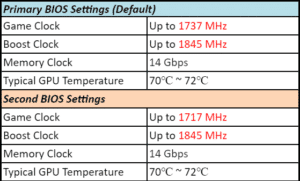SAPPHIRE PULSE Radeon RX 5500 XT 4G OC
The video card we have to review today is from SAPPHIRE. This is the SAPPHIRE PULSE Radeon RX 5500 XT 4G OC. That means it is a 4GB model with a factory overclock. It isn’t a huge factory overclock, but SAPPHIRE will be offering different models based on the Radeon RX 5500 XT. SAPPHIRE will have a NITRO model available and 8GB variants as well.
In fact, the day before this launch we just received the 8GB variant of the SAPPHIRE PULSE. Therefore, in the future, we will take a look at that video card and do direct 4GB versus 8GB performance testing in the future, so stay tuned.
Dual-BIOS
This video card has a dual-BIOS. There is a switch atop the video card that has two different performance options. The video card will ship with the switch in position 1 which is the primary default setting. The optional position 2 is a secondary setting.
This table above shows what the differences are in the two BIOS positions. The default factory overclock on this video card is a game clock of 1737MHz. This factory overclock is 20MHz over the reference specification of 1717MHz. The secondary BIOS switch puts the card into the reference clock speed setting. The main reason you may want to do this is to lower fan noise. However, we have to say the fans are fairly silent anyway at default BIOS position, you can’t hear them at all at full-load.
Specs
These are the official specifications on this video card. You can see the factory overclock is 1737MHz versus 1717MHz. It has the same overall boost clock of 1845MHz. The memory is 4GB clocked at 14GHz and GDDR6. It has a dual UEFI BIOS. It’s 2 slots with dual axial fans and two-ball bearing. It has a backplate and supports PCIe 4.0 and requires one 8-pin power adapter.










The video card itself has three heat-pipes that make contact with the GPU. The heat spreads out to a large heatsink. In fact, the heatsink and shroud extend beyond the size of the PCB. The PCB on this video card is only 7 inches long. However, the heatsink and fan shroud come out another 2 inches past the PCB making the video card 9 inches in total length. That means there is extra heatsink area for heat dissipation. The heatpipes pull heat to both ends of the heatsinks.
This video card has three DisplayPorts and one HDMI port. It does require an 8-pin power connector.
SAPPHIRE TRIXX
SAPPHIRE sent us over the latest TRIXX software version 7.1.3 to check out with this video card. It offers many functions to view information about the video card and to monitor many sensor inputs from the video card. It even has a unique ability you can enable to improve framerates.




TRIXX Boost will run games at a higher FPS by reducing the rendering resolution slightly and upscaling the final image. Naturally, this is something we won’t use for evaluation purposes today, so we don’t skew benchmarks. However, this might be a nifty feature to check out if you have a high-resolution display and maybe want to play games at your native resolution. The program will downscale the resolution of the game, and upscale it to your native resolution. It’s a bit of a trick, and you won’t really be playing at a high rendering resolution, but it could help in certain situations as we mentioned.



